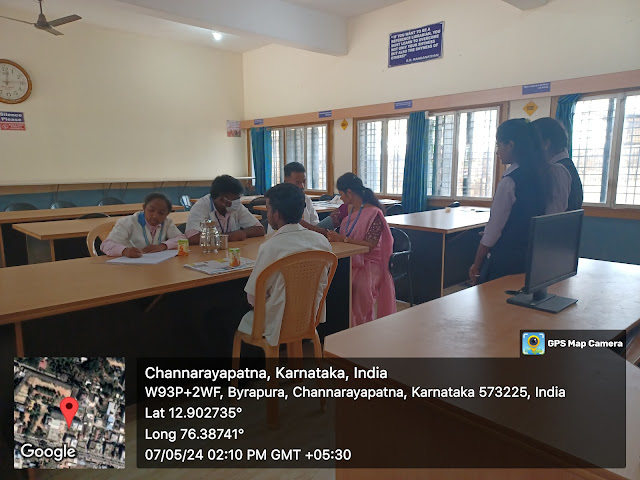On Tuesday, May 7, 2024 at 10.30 a.m. in the library, a Medical Health Examination was organized by the Youth Red Cross and Red Ribbon Unit in collaboration with Vaidya Institute of Nursing and Paramedical Sciences, Channarayapatna. In this health drive blood pressure, blood sugar, weight and blood group were checked for first year students along with teaching and non-teaching staff. Twelve Vaidya Institute of Nursing and Paramedical Sciences staff members, led by Puneeth, arrived and efficiently performed the examinations.
The blood sugar
level, blood glucose level, or glycemia is the measure of glucose concentrated
in the blood. The body tightly regulates blood glucose levels as a part of
metabolic homeostasis. From 90 to 130 mg/dL (5.0 to 7.2 mmol/L) for adults.
From 90 to 130 mg/dL (5.0 to 7.2 mmol/L) for children, 13 to 19 years old. From
90 to 180 mg/dL (5.0 to 10.0 mmol/L) for children, 6 to 12 years old. From 100
to 180 mg/dL (5.5 to 10.0 mmol/L) for children under 6 years old.Now a days
blood. High blood sugar—or hyperglycemia—occurs when an individual's glucose
levels rise to 240 mg/dL or higher. If untreated, hyperglycemia may lead to
ketoacidosis, a condition commonly known as diabetic coma. Ketones are waste
products made when the body breaks down fats due to insufficient insulin.
Blood pressure is
the pressure of circulating blood against the walls of blood vessels. Normal
blood pressure for most adults is defined as a systolic pressure of less
than 120 and a diastolic pressure of less than 80. Elevated blood pressure is
defined as a systolic pressure between 120 and 129 with a diastolic pressure of
less than 80. Now days, both are the very risk health issues and early
detection and management is the only way to overcome the problems. Many of our
students including staffs were not aware of their blood group. With a clear
goal in mind, we conducted this campaign, screening over 100 students, and it
concluded satisfactorily.













